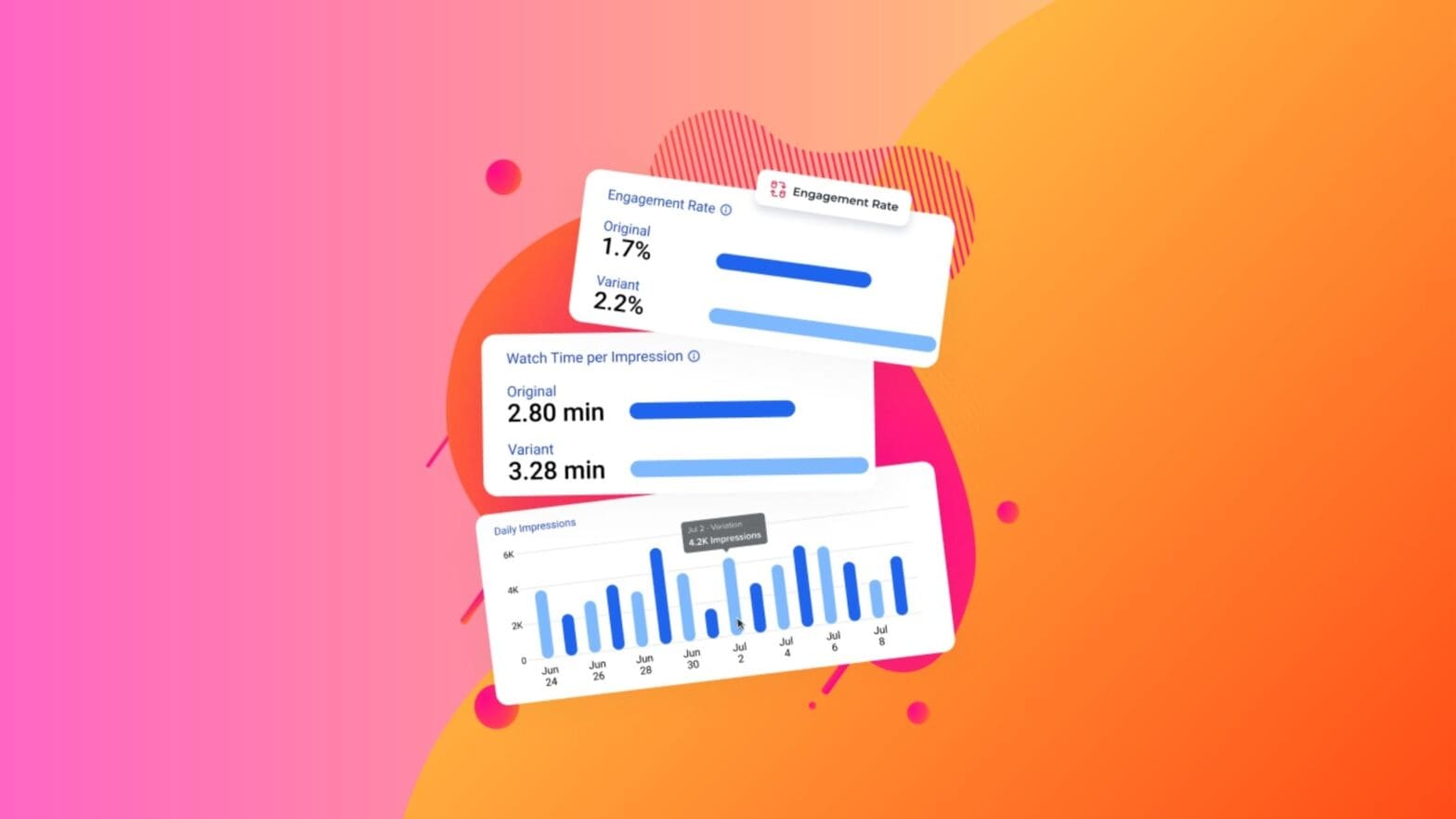If you’re not A/B testing your YouTube content, you’re missing out on valuable insight, potential views, subs, and watch time.
We recently rolled out a new and improved TubeBuddy A/B testing tool to all TubeBuddy Legend and above licenses.
But before we get to that, let’s talk a little about A/B testing on YouTube.
What is A/B Testing?
A/B testing on YouTube lets creators present a couple of different versions of a thumbnail, title, description, and/or tags to viewers. Whichever variant is the most successful in snagging viewers is the winner.
At its most basic, A/B testing on YouTube can tell you whether thumbnail A or thumbnail B gets your video more attention. However, a well thought out A/B testing methodology (and a YouTube A/B testing tool that offers the flexibility to fine tune A/B tests) offers creators and channel managers more testing granularity and much deeper insights.
TubeBuddy Legend users have always had access to our YouTube A/B testing tools. With the latest TubeBuddy release, these A/B testing tools have gotten even better, thanks in part to feedback from creators and YouTube channel managers.
How TubeBuddy and YouTube A/B Testing Compare
Recently, YouTube has been rolling out basic A/B testing which it calls YouTube Test & Compare. The key difference between TubeBuddy YouTube A/B testing tools and YouTube’s own Test & Compare is that the latter only allows creators to test one element: thumbnails. It also only allows creators to test against one success metric: watch time.
TubeBuddy YouTube A/B testing tools, on the other hand, allow creators to test multiple factors and provide the flexibility to run any split test that will be useful in their overall content strategy.
In addition to more flexibility in how creators define success for their YouTube A/B testing, the latest TubeBuddy feature rollout also includes an updated A/B testing results dashboard. Here, creators can dig into deeper insights around their A/B tests to see how variants performed.
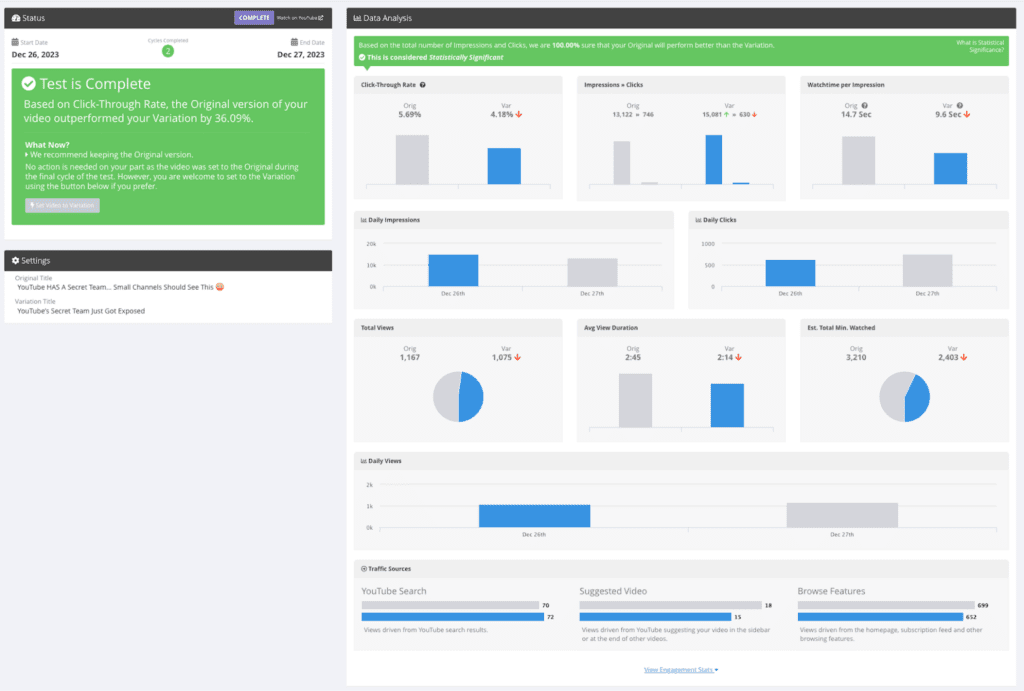
In the results dashboard, creators and channel managers can dig into a wealth of data including click through rate, watch time per impression, engagement rate, daily impressions, clicks, total views, and more for both the A and the B in the A/B test.
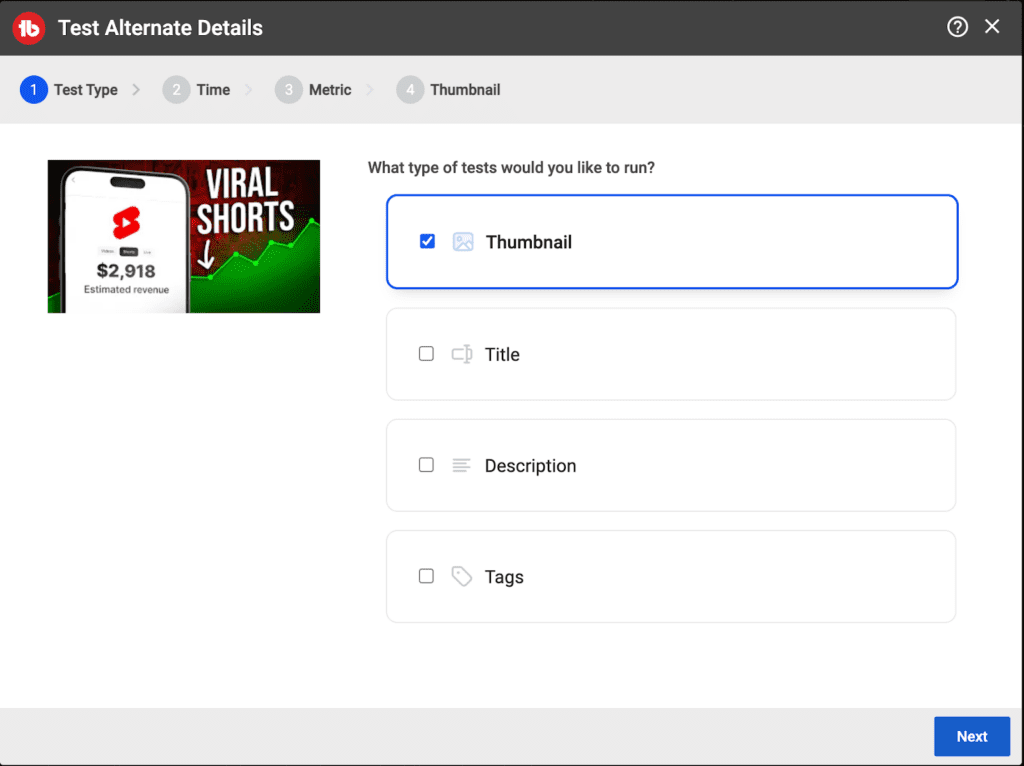
With TubeBuddy A/B testing, creators and channel managers can:
A/B Test YouTube Thumbnails
The importance of thumbnails on YouTube cannot be overstated. Creating great YouTube thumbnails is an art. A/B testing YouTube thumbnails brings the science to give creators hard and fast data on what drives viewers to click on and engage with their videos.
A/B Test YouTube Titles
After your thumbnail stops would-be viewers mid-scroll, the next place they’ll look is the title. Title is key as the YouTube algorithm tries to understand your content. A great title hooks the viewer while also providing cues to said algorithm. Running A/B tests on titles can help creators perfect the craft of creating killer titles.
A/B Test YouTube Descriptions
Video descriptions are important. YouTube says so. The description field — especially the first 200 characters of the description field — is important to optimize videos for search. A great description will impact how YouTube’s algorithm understands your video and who it presents your video to, which in turn can impact click through rate (CTR).
Discerning viewers will also read your description to understand if a video is worth their time, impacting engagement, and watch time. Both of which you can test against with TubeBuddy A/B Testing.
A/B Test YouTube Tags
Most viewers will never take the time to look at the tags that accompany a video. That doesn’t mean tags aren’t important. The YouTube algorithm uses tags as a cue to understand what a video is about, how it relates to other videos on the platform, and so on. Running A/B tests with different tag lists (which TubeBuddy users can save with the View and Copy Video Tags tool) can help creators create and save the perfect default tags for their videos.
Testing More than Watch Time
YouTube pushes watch time above all other metrics. While it’s the main measure of success on YouTube, watch time is a broad metric and many factors play into whether a video racks up that all-important watch time. But we think creators should have the flexibility to run A/B tests based on more than just watch time.

TubeBuddy YouTube A/B testing tools let creators create more meaningful A/B tests by selecting which metric they want to use to measure success:
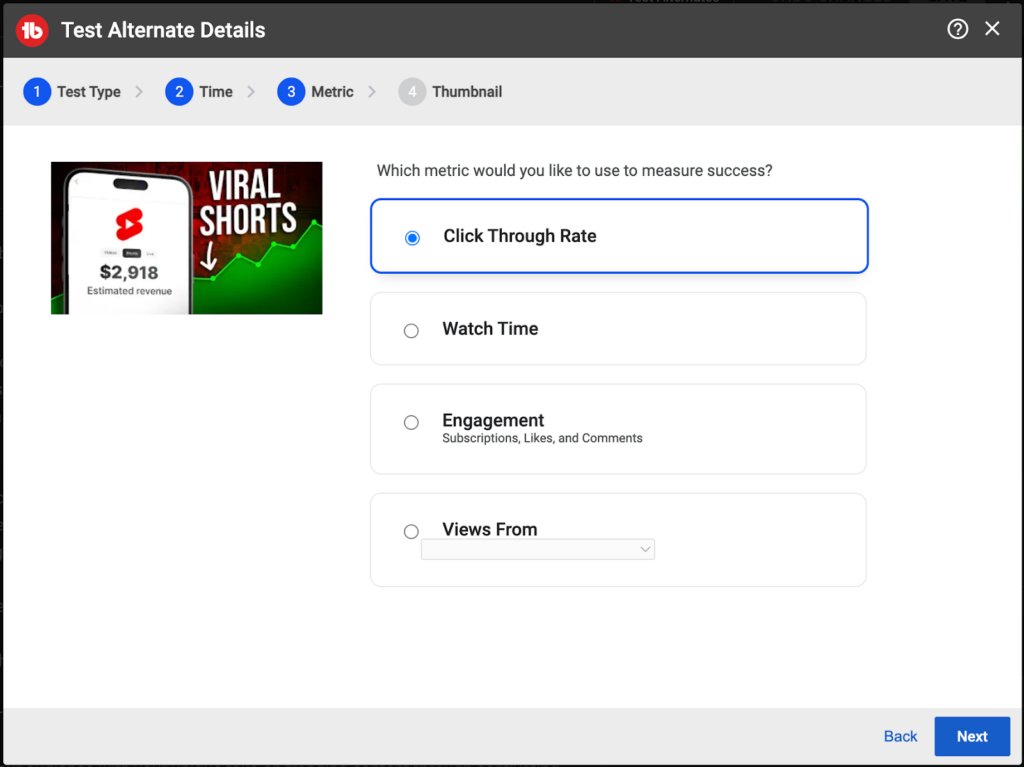
Click Through Rate (CTR) A/B Test
How many people saw your thumbnail or title in their feed and clicked through to watch? When testing thumbnails or titles using CTR as your success metric, you’re doing a true test of which thumbnail or title grabs the viewer’s attention as they’re scrolling on YouTube.
Video description and tags aren’t typically visible unless viewers click through. However, they do impact how the YouTube algorithm understands and presents your content. A/B testing descriptions or tags and using CTR as the success metric can help creators find new, receptive audiences for their content while getting some data on how those audiences respond to said content.
Watch Time A/B Test
While it’s a broad metric, watch time is what it all comes down to. With TubeBuddy, creators can test not just thumbnails as they relate to watch time but video titles, descriptions, and even tags. This flexibility allows creators to test a hypothesis (for example: how using a specific word or phrase in a title or description will impact watch time) and get reliable data to prove or disprove it.
Engagement A/B Test
Engagement speaks to how invested viewers are in the content they’re watching. If a viewer likes a video, subscribes to a channel, or feels compelled to add their two cents in the comments, they are engaging with the content.
Views are important but engaging a community is key. Running YouTube A/B tests using engagement as the marker for success helps creators better understand what their growing community responds best to.
A/B Testing Based on Source
With TubeBuddy’s updated YouTube A/B testing tools, creators can dive deep into how viewers from a given source react to a given thumbnail, title, or description. Creators can divide traffic sources and A/B test based on:
- Direct
Viewers who landed on a video directly, from an email or social post for example. - YouTube Search
Viewers who found a video via the YouTube search bar. - Suggested Video
Viewers who clicked through on a suggested video after watching another video on YouTube. - External Website
Viewers who found their way to a creator’s video by clicking through from a website or blog, for example. - YouTube Channel Page
Viewers who came to a video via the creator’s YouTube channel page. - Subscribers
Viewers who are subscribed to the channel. - Advertising
Viewers who arrived at a video via an ad. - Playlist
Viewers who found the video through a YouTube playlist.

YouTube A/B Testing Should be Flexible
The TubeBuddy A/B testing tools are designed to grow with creators and provide the flexibility to run whatever YouTube A/B tests a creator or channel manager thinks will be valuable. Whether that’s testing a hypothesis or just seeing which thumbnail drives more clicks.
TubeBuddy A/B testing tools are designed with that flexibility in mind, so creators and channel managers can run the A/B tests that make sense for their content and their channel.
For example:
- Test how subscribers specifically respond to title variants or thumbnails
- Test video retention with title A vs title B for viewers coming from a given ad or social post
- Test which video description performs best for viewers finding your content through YouTube search
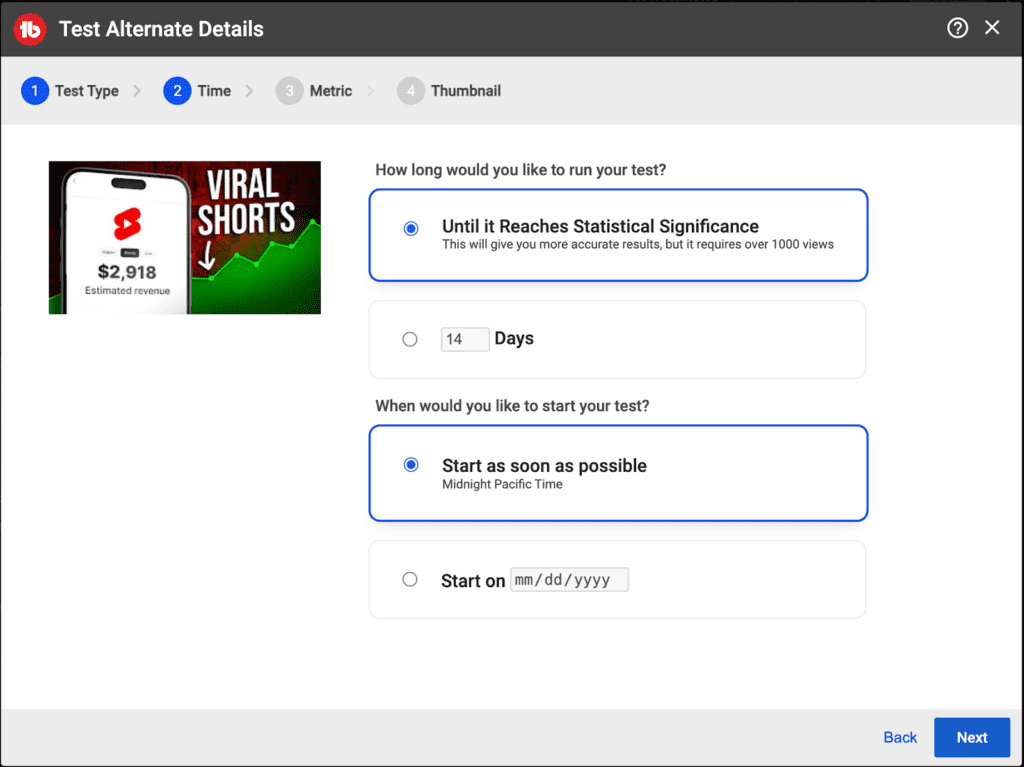
By default, TubeBuddy A/B tests will run until they reach statistical significance, which requires 1,000+ views. Once a clear winner is determined, the lower-performing variant will be dropped and the winning variant will take over automatically.
Tests can also be run over a set period of time, allowing creators or channel managers to gather data over more views, or allowing smaller channels to make decisions before a video reaches 1,000+ views.
So, while YouTube’s own Test & Compare feature is good, TubeBuddy’s YouTube A/B testing feature is essential for creators and channel managers looking to run more granular A/B tests.
With this level of control over the A/B testing process, TubeBuddy not only helps creators and channel managers to optimize their content but to deepen their understanding of their audience’s preferences in order to make informed, data-driven decisions.
get an unfair advantage on YouTube
Give your YouTube channel the upper hand and easily optimize for more views, more subs, and more of every metric that matters.
